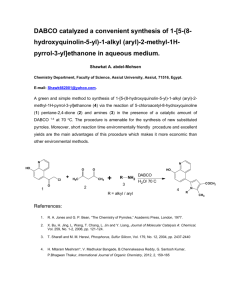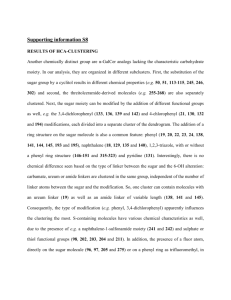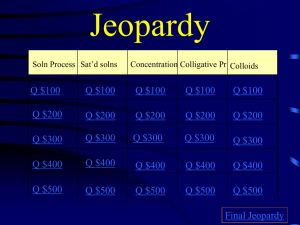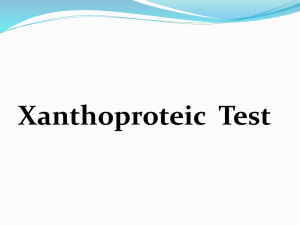A Straightforward Route to Enantiopure Pyrrolizidines and
advertisement
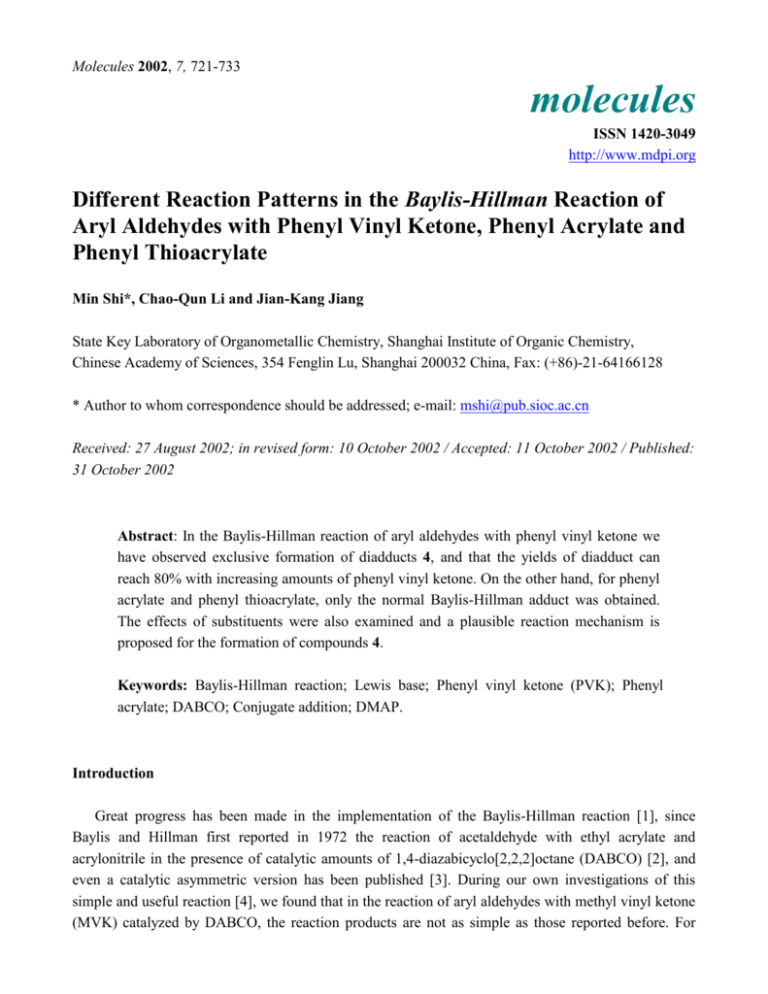
Molecules 2002, 7, 721-733 molecules ISSN 1420-3049 http://www.mdpi.org Different Reaction Patterns in the Baylis-Hillman Reaction of Aryl Aldehydes with Phenyl Vinyl Ketone, Phenyl Acrylate and Phenyl Thioacrylate Min Shi*, Chao-Qun Li and Jian-Kang Jiang State Key Laboratory of Organometallic Chemistry, Shanghai Institute of Organic Chemistry, Chinese Academy of Sciences, 354 Fenglin Lu, Shanghai 200032 China, Fax: (+86)-21-64166128 * Author to whom correspondence should be addressed; e-mail: mshi@pub.sioc.ac.cn Received: 27 August 2002; in revised form: 10 October 2002 / Accepted: 11 October 2002 / Published: 31 October 2002 Abstract: In the Baylis-Hillman reaction of aryl aldehydes with phenyl vinyl ketone we have observed exclusive formation of diadducts 4, and that the yields of diadduct can reach 80% with increasing amounts of phenyl vinyl ketone. On the other hand, for phenyl acrylate and phenyl thioacrylate, only the normal Baylis-Hillman adduct was obtained. The effects of substituents were also examined and a plausible reaction mechanism is proposed for the formation of compounds 4. Keywords: Baylis-Hillman reaction; Lewis base; Phenyl vinyl ketone (PVK); Phenyl acrylate; DABCO; Conjugate addition; DMAP. Introduction Great progress has been made in the implementation of the Baylis-Hillman reaction [1], since Baylis and Hillman first reported in 1972 the reaction of acetaldehyde with ethyl acrylate and acrylonitrile in the presence of catalytic amounts of 1,4-diazabicyclo[2,2,2]octane (DABCO) [2], and even a catalytic asymmetric version has been published [3]. During our own investigations of this simple and useful reaction [4], we found that in the reaction of aryl aldehydes with methyl vinyl ketone (MVK) catalyzed by DABCO, the reaction products are not as simple as those reported before. For Molecules 2002, 7 722 example, using p-nitrobenzaldehyde (1.0 eq) and MVK (2.0 eq) as substrates in the presence of catalytic amounts of DABCO (0.1 eq) in DMSO or DMF, we found that, besides the normal BaylisHillman reaction product 1a, compound 2a was also formed at the same time as a 2:3 mixture of synand anti-isomers [5] (Scheme 1) and the substituent effects of aryl aldehydes were also examined in detail [5]. Scheme 1 p-O2NPh CHO + O C OH Lewis base Me CH p-O2NPh solvent 1a OH CHa p-O2NPh + C O C Me CH2 O C Me O H 2C C C Me CH2 2a CHb This interesting result stimulated us to further examine the influence of the R group of the BaylisHillman acceptor [C=C-C(O)R] on this reaction. Thus, we synthesized phenyl vinyl ketone (PVK) [6], phenyl acrylate [7], and phenyl thioacrylate [8] as the Baylis-Hillman acceptors and carefully examined the reaction products formed under the traditional Baylis-Hillman reaction conditions. Results and Discussion We found that, in the reaction of p-nitrobenzaldehyde (1.0 eq.) with PVK (1.0 eq.) in the presence of DABCO (10 mol-%) in DMF, the corresponding Baylis-Hillman adduct 3a (i.e., the normal Baylis-Hillman adduct) was not formed at all. The major reaction product was a mixture of synand anti-isomers of the 1:2 adduct 4a, along with some PVK dimer (Scheme 2). Of course, as expected, 4a was obtained in higher yields when 1.0 eq. p-nitrobenzaldehyde and 2.0 eq. of PVK were used in the presence of DABCO (10 mol-%). Results are summarized in Table 1. When the reaction was carried out in DMSO, THF or dichloromethane (CH2Cl2), similar results were obtained (Table 1, Entries 1-3). Using 4-(dimethylamino)pyridine (DMAP) as the Lewis base under the same reaction conditions, 4a was obtained in lower yields (Table 1, entries 4-5). Increasing the amounts of PVK did not improve the yields of 4a (Table 1, Entries 6-7). At lower temperatures (-30 oC), 4a was obtained in 70% yield (Table 1, Entry 9) and with PBu3 as the Lewis base, only traces of 4a were obtained. The optimized reaction conditions were found to be reaction of 1.0 eq. aryl aldehyde with 2.0 eq. PVK in the presence of 10 mol-% DABCO in DMF. Molecules 2002, 7 723 Scheme 2 OH CH p-O2NPh p-O2NPh CHO + O C Ph C CH2 3a O C Lewis base Ph O C OH solvent a p-O2NPh CH Ph O H2C C C Ph CH2 O CHb Ph + O Ph CH2 PVK dimer 4a Table 1. Baylis-Hillman reactions of p-nitrobenzaldehyde (1.0 eq.) with phenyl vinyl ketone (2.0 eq.) in the presence of Lewis base (0.1 eq.). entry Yield [%] a) Temp. o [ C] Time [h] 4ae) PVK dimer Lewis base solvent 1 DABCO DMSO 20 60 75 10 2 DABCO DMF 20 60 88 14 3 DABCO CH2Cl2 20 60 81 12 4 DABCO THF 20 60 78 16 5 DMAP DMSO 20 60 65 21 6 DMAP DMF 20 60 63 20 7 DABCO DMFb) 20 60 80 11 8 DABCO DMFc) 20 60 60 13 9 PBu3 DMF 20 60 trace 36 10 DABCO DMF -30 60 70 8 a) Isolated yields. b) Mole ratio of p-nitrobenzaldehyde:PVK= 1:3.0. c) Mole ratio of p-nitrobenzaldehyde:PVK= 1:4. d) syn:anti= 2:3. We next investigated the reactions of other aryl aldehydes with PVK under the optimized reaction conditions (Scheme 3). With electron deficient aryl aldehydes, such as nitrobenzaldehydes or pyridylaldehydes, the reaction proceeded smoothly to give 4 in good yields. However, with Molecules 2002, 7 724 p-chlorobenzaldehyde or benzaldehyde, only trace amounts of the 1:2 adduct 4 were obtained and the PVK dimer was formed almost exclusively (Scheme 3, Table 2) [7]. In all cases, the normal BaylisHillman adduct 3 was not formed. Scheme 3 R CHO O C + Lewis base Ph R DMF, 20 oC OH CH O C Ph CH O + H2C C C Ph CH2 b: R= m-NO2Ph, c: R= o-NO2Ph, d: R=2-pyridyl, e: R= 3-pyridyl, f: R= Ph, g: R= p-ClPh. O Ph O CH2 Ph PVK dimer 4 Table 2. Baylis-Hillman reactions of aryl aldehydes (1.0 eq) with phenyl vinyl ketone (2.0 eq.) in the presence of DABCO (0.1 eq). entry a) Time [h] Yield [%]a) R Lewis base 1 m-NO2Ph DABCO 60 76 (2:3) 15 2 o-NO2Ph DABCO 60 79 (3:4) 16 3 2-pyridyl DABCO 70 82 (3:5) 20 4 3-pyridyl DABCO 70 81 (2:3) 16 5 Ph DABCO 70 trace 33 6 p-ClPh DABCO 70 trace 29 4b) PVK dimer Isolated yields. b)syn- and anti mixture. On the other hand, the Baylis-Hillman reactions with phenyl acrylate or phenyl thioacrylate as an acceptor were also examined (Schemes 4 and 5; results are summarized in Table 3). With phenyl acrylate as the acceptor, the normal Baylis-Hillman adducts 5 was exclusively obtained in most cases (Table 3, entries 1-2 and 4-8). Only in the reaction of o-nitrobenzaldehyde with phenyl acrylate, was diadduct 6c formed in 29% (Table 3, Entry 3). However, with phenyl thioacrylate as a Baylis-Hillman acceptor, only in the reaction of p-chlorobenzaldehyde with phenyl thioacrylate, the corresponding Baylis-Hillman adduct 7 was obtained in good yield (Scheme 5). The reactions of other aryl aldehydes with phenyl thioacrylate were either very sluggish or gave many unidentified products. Molecules 2002, 7 725 Scheme 4 R CHO O C + OH CH Lewis base OPh solvent, 20 oC R C O C OH OPh + CH2 a: R= p-NO2Ph, b: R= m-NO2Ph, c: R= o-NO2Ph, d: R= p-BrPh, e: R= p-ClPh, f: R= Ph, g: R= PhCH=CH, h: R= 3-pyridyl. O C CH OPh R CH O H2C 5 C C OPh CH2 6 Table 3. Baylis-Hillman reactions of aldehydes (1.0 eq) with phenyl acrylate (2.0 eq) in the presence of Lewis base (0.1 eq). entry a) solvent Yield [%] a) Time [h] 5 6 R Lewis base 1 p-NO2Ph DABCO DMSO 40 75 0 2 m-NO2Ph DABCO DMF 40 74 0 3 o-NO2Ph DABCO DMF 40 53 29 4 p-BrPh DABCO DMF 50 78 0 5 p-ClPh DABCO DMF 50 71 0 6 Ph DABCO DMF 50 79 0 7 PhCH=CH DABCO DMF 40 57 0 8 3-pyridyl DABCO DMF 40 78 0 Isolated yields. Scheme 5 R CHO + R= p-ClPh, O C DABCO SPh DMF, 20 oC R OH CH O C SPh C CH2 7, 75% O + PhS O CH2 SPh 8 To the best of our knowledge, the exclusive formation of a diadduct in the traditional BaylisHillman reaction in which phenyl vinyl ketone (PVK) is used as the acceptor has never been disclosed before. To clarify the mechanism of formation of 4, we carried out reactions of p-nitrobenzaldehyde Molecules 2002, 7 726 (1.0 equiv.) with PVK dimer (1.0 equiv.) in the presence of catalytic amounts of DABCO (0.1 equiv.). Since we found that no reaction occurred under these conditions (Scheme 6), we believe that the diadduct 4 was derived from a second reaction of normal Baylis-Hillman adduct 3 with PVK because we have already proven that the diadduct 2a can be obtained from the reaction of 1a with MVK in the presence of DABCO (10 mol-%) in DMF (Scheme 6). Scheme 6 O O + p-O2NPh CHO DABCO Ph Ph CH2 OH CH O C p-O2NC6H4 O Me + OH CH DABCO O C Me CH O p-O2NC6H4 Me CH2 no reaction DMSO or DMF, r.t DMF, r.t C H2C 1a 2a Scheme 7 N N O C N + Ar CHO N N + - + N Ph Me CH2 Ar Ph OH CH Ar O O O O - Ph N C + Ph N CH2 1 OH OH CH Ar O C CH2 N Ph + Ar N + O O - N CH Ph N + CH2 - O 1 Ph Ph OH CH Ar O C Ph CH O H2C C CH2 2 Ph N + N Molecules 2002, 7 727 In Scheme 7, we formulate a plausible reaction mechanism. Two reactions occur for the traditional Baylis-Hillman reaction of aryl aldehydes with PVK. One is the normal Baylis-Hillman reaction, which involves the 1,2-addition of the PVK-derived anion to p-nitrobenzaldehyde. Another is the conjugated addition (Michael addition) of the anion derived from a second molecule of PVK to 3 via intermediate 4’ (Scheme 7). Thus, the normal Baylis-Hillman adduct 3 formed can more easily undergo the next conjugate addition (Michael addition) of the anion derived from a second molecule of PVK to afford exclusively the diadduct 4. Conclusions We have found that a diadduct 4 was formed exclusively in the Baylis-Hillman reaction of aryl aldehydes with phenyl vinyl ketone (PVK). It was confirmed the 4 was derived from a second reaction of the normal Baylis-Hillman adduct with PVK via a conjugate addition reaction. On the other hand, with phenyl acrylate or phenyl thioacrylate as acceptors, only the normal Baylis-Hillman reaction products were produced. Efforts are currently underway to further elucidate the mechanistic details of this reaction and to disclose its scope and limitations. Acknowledgements We thank the State Key Project of Basic Research (Project 973) (No. G2000048007) and the National Natural Science Foundation of China for financial support (20025206). We also thank the Inoue Photochirogenesis Project (ERATO, JST) for the donation of chemical reagents. Experimental General IR spectra were recorded on a Nicolet AV-360 spectrometer. 1H-NMR spectra (300 MHz) were recorded for CDCl3 solutions on a Bruker AM-300 spectrometer with tetramethylsilane (TMS) as internal standard; J-values are in Hz. Mass spectra were recorded with a HP-5989 instrument and HRMS were measured on a Finnigan MA+ mass spectrometer. Organic solvents were dried by standard methods when necessary. Commercially obtained reagents were used without further purification. All reactions were monitored by TLC using Huanghai GF254 silica gel coated plates. Flash Column Chromatography was carried out using 200-300 mesh silica gel under pressure. The syn- and anti-isomers of 4 were not separable, thus, the ratios of syn and anti isomers are determined from 1HNMR spectroscopic data and their HRMS data were obtained from anti- and syn-mixtures as well. Molecules 2002, 7 728 Preparation of phenyl vinyl ketone. The phenyl vinyl ketone starting material was prepared according to Scheme 8 [6]. Scheme 8 O + Me3N O Steam distillation Ph Ph Cl- A solution of the ammonium salt (5 g) in water (200 mL) was distilled at 90 oC. The distillate was extracted with ether (3 x 20 mL) and the organic layer was dried over anhydrous Na2SO4. The solvent was removed under reduced pressure and residue was purified by flash silica gel chromatography (eluent: ethyl acetate/petroleum ether = 1/10) to give phenyl vinyl ketone (PVK) (1.6 g, 30%) as a colorless oil; 1H-NMR: 5.94 (1H, dd, J = 10.5, 1.8 Hz, =CH), 6.45 (1H, dd, J = 16.8, 1.8 Hz, =CH), 7.17 (1H, dd, J = 16.8, 10.5 Hz, =CH), 7.46-7.51 (2H, m, Ar), 7.56-7.59 (1H, m, Ar), 7.94-7.97 (2H, m, Ar). Preparation of phenyl acrylate. The phenyl acrylate starting material was prepared according to Scheme 9 [7]. Acroylchloride (7.28 g, 80 mmol) in dichloromethane (10 mL) was added within 0.5 h. to a solution of phenol (7.5 g, 80 mmol) and triethylamine (10.1 g, 100 mmol) in dichloromethane (20 mL). Scheme 9 OH O + Cl Et3N CH2Cl2 O O The reaction mixture was stirred at room temperature for 24 h, then washed with water (2 x 30 mL) and extracted with dichloromethane (2 x 10 mL). The organic layer was dried over anhydrous Na2SO4. The solvent was removed under reduced pressure and residue was purified by flash silica gel chromatography (eluent: petroleum ether) to give phenyl acrylate (9.0 g, 76%) as a colorless oil; 1 H-NMR: 6.00 (1H, d, J = 11.1 Hz, =CH), 6.32 (1H, dd, J = 17.1, 11.1 Hz, =CH), 6.60 (1H, d, J = 17.1 Hz, =CH), 7.11-7.14 (2H, m, Ar), 7.24-7.26 (1H, m, Ar), 7.37-7.42 (2H, m, Ar). Typical reaction procedure for the Baylis-Hillman reaction. Phenyl vinyl ketone (PVK) (138 mg, 1.0 mmol) was added to a solution of DABCO (6 mg, 0.05 mmol) and p-nitrobenzaldehyde (76 mg, 0.50 mmol) in DMF (0.50 mL) and the reaction mixture was stirred at room temperature for 60 h. The reaction product was extracted with dichloromethane (10.0 Molecules 2002, 7 729 mL) and washed with water (10.0 mL x 3). The organic layer was dried over anhydrous MgSO4, the solvent was removed under reduced pressure and the residue was purified by flash silica gel column chromatography (eluent: 1:4 ethyl acetate-petroleum ether) to give the product 4a (a 2:3 syn and anti mixture, 180 mg, 88%) and PVK dimer (25 mg, 14%) as colorless oils. The syn and anti ratio of 4a was determined from the 1H-NMR spectral data based on the J values of Ha and Hb (see Scheme 1) because the anti-isomer usually shows a bigger J value (for anti-4a: JHaHb = 6.3 Hz, for syn-4a: JHaHb = 2.8 Hz). 2-[Hydroxy-(4-nitrophenyl)methyl]-4-methylene-1,5-diphenylpentane-1,5-dione (4a): syn-4a: IR (KBr): 1649 and 1668 cm-1 (C=O); 1H-NMR: 2.86-2.93 (2H, m, CH2), 4.09 (1H, d, J = 2.6 Hz, OH), 4.20-4.30 (1H, m, CH), 5.16 (1H, dd, J = 4.8, 2.6 Hz, CH), 5.55 (1H, s), 5.82 (1H, s), 7.20-7.60 (10H, m, Ar), 7.87 (2H, d, J = 8.6 Hz, Ar), 8.10 (2H, d, J = 8.6 Hz, Ar); EI-MS: m/e 397 (M+-18, 0.2), 378 (M+-37, 0.2), 159 (M+-256, 50.1), 105 (M+-310, 100); HRMS: C18H16O2 requires 264.1150, found: (EI) m/z 264.1135 (M+-151.0270); anti-4a: IR (KBr): 1649 and 1668 cm-1 (C=O); 1H-NMR: 2.93-3.10 (2H, m, CH2), 4.30-4.40 (1H, m, CH), 4.42 (1H, d, J = 8.2 Hz, OH), 5.06 (1H, dd, J = 8.2, 4.6 Hz, CH), 5.74 (1H, s), 6.07 (1H, s), 7.20-7.60 (10H, m, Ar), 7.87 (2H, d, J = 8.6 Hz, Ar), 8.10 (2H, d, J = 8.6 Hz, Ar); EI-MS: m/e 397 (M+-18, 0.2), 378 (M+-37, 0.2), 159 (M+-256, 50.1), 105 (M+-310, 100); HRMS: C18H16O2 requires 264.1150, found: (EI) m/z 264.1135 (M+-151.0270). 4-Methylene-1,5-diphenylpentane-1,5-dione (PVK dimer): a colorless oil; IR (KBr): 1650 and 1680 cm-1 (C=O); 1H-NMR: 2.91 (2H, t, J = 7.3 Hz, CH2), 3.23 (2H, t, J = 7.3 Hz, CH2), 5.67 (1H, s), 5.96 (1H, s), 7.30-7.55 (6H, m, Ar), 7.70-7.75 (2H, m, Ar), 7.90-8.0 (2H, m, Ar); EI-MS: m/e 264 (M+, 1.0), 159 (M+-105, 63.8), 105 (M+-159, 100), 77 (M+-187, 54.2); HRMS: C18H16O2 requires 264.1150, found: (EI) m/z 264.1185 (M+). 2-[Hydroxy-(3-nitrophenyl)methyl]-4-methylene-1,5-diphenylpentane-1,5-dione (4b) (syn- and antimixture= 2:3): syn-4b: a colorless oil; IR (KBr): 1645, 1675 cm-1 (C=O); 1H-NMR: 2.90-3.0 (1H, m, CH2), 3.10 (1H, dd, J = 13.7, 8.6 Hz, CH2), 4.09 (1H, d, J = 2.6 Hz, OH), 4.20-4.30 (1H, m), 5.17 (1H, dd, J = 2.6, 2.6 Hz), 5.56 (1H, s, CH), 5.82 (1H, s, CH), 7.20-7.52 (9H, m, Ar), 7.55-7.82 (1H, m, Ar), 7.83-7.95 (2H, m, Ar), 8.0-8.08 (1H, m, Ar), 8.33 (1H, s, Ar); EI-MS: m/e 397 (M+-18, 0.12), 378 (M+-37, 1.0), 159 (M+-256, 55.0), 105 (M+-310, 100); HRMS: C25H21NO5 requires 415.1420, found: (EI) m/z 415.1431 (M+); anti-4b: a colorless oil; IR (KBr): 1645, 1675 cm-1 (C=O); 1H-NMR: 2.95 (2H, dd, J = 14.2 7.4 Hz, CH2), 4.32 (1H, d, J = 5.2 Hz, OH), 4.38-4.45 (1H, m, CH), 5.12 (1H, dd, J = 5.2 2.0 Hz), 5.73 (1H, s, CH), 6.07 (1H, s, CH), 7.20-7.52 (9H, m, Ar), 7.55-7.82 (1H, m, Ar), 7.837.95 (2H, m, Ar), 8.0-8.08 (1H, m, Ar), 8.24 (1H, s, Ar); EI-MS: m/e 397 (M+-18, 0.12), 378 (M+-37, 1.0), 159 (M+-256, 55.0), 105 (M+-310, 100); HRMS: C25H21NO5 requires 415.1420, found: (EI) m/z 415.1431 (M+). Molecules 2002, 7 730 2-[Hydroxy-(2-nitrophenyl)methyl]-4-methylene-1,5-diphenylpentane-1,5-dione (4c) (syn- and antimixture = 3:4): syn-4c: a colorless oil; IR (KBr): 1645, 1675 cm-1 (C=O); 1H-NMR: 2.85 (1H, dd, J = 13.4 4.3 Hz, CH), 3.01 (1H, dd, J = 13.4, 6.5 Hz, CH), 4.33 (1H, s, OH), 4.40-5.02 (1H, m, CH), 5.47 (1H, s, CH), 5.74 (1H, d, J = 2.4 Hz, CH), 5.79 (1H, s, CH), 7.10-7.80 (12H, m, Ar), 7.98 (1H, d, J = 8.6 Hz, Ar), 8.02 (1H, dd, J = 8.0 7.3 Hz, Ar); EI-MS: m/e 378 (M+-37, 0.6), 264 (M+-151, 7.6), 159 (M+-256, 63.5), 105 (M+-310, 100); HRMS: C25H21NO5 requires 415.1420, found: (EI) m/z 415.1233 (M+); anti-4c: a colorless oil; IR (KBr): 1645, 1675 cm-1 (C=O); 1H-NMR: 2.99 (2H, dd, J = 13.7 10.0 Hz, CH2), 4.40-5.02 (1H, m, CH), 4.94 (1H, d, J = 8.5 Hz, OH), 5.61 (1H, dd, J = 4.3, 3.8 Hz, CH), 5.88 (1H, s, CH), 6.20 (1H, s, CH), 7.10-7.80 (12H, m, Ar), 7.81 (1H, d, J = 8.6 Hz, Ar), 7.88 (1H, d, J = 8.6 Hz, Ar); EI-MS: m/e 378 (M+-37, 0.6), 264 (M+-151, 7.6), 159 (M+-256, 63.5), 105 (M+-310, 100); HRMS: C25H21NO5 requires 415.1420, found: (EI) m/z 415.1233 (M+). 2-(Hydroxy-pyridin-2-yl-methyl)-4-methylene-1,5-diphenylpentane-1,5-dione (4d) (syn- and antimixture= 3:5): syn-4d: a colorless oil; IR (KBr): 1645, 1675 cm-1 (C=O); 1H-NMR: 2.90-3.05 (2H, m, CH), 4.30-4.41 (1H, m, CH), 4.53 (1H, d, J = 3.2 Hz, OH), 5.02 (1H, t, J = 4.2 Hz, CH), 5.48 (1H, s, CH), 5.83 (1H, s, CH), 7.0-7.70 (11H, m, Ar), 7.80-7.92 (2H, m, Ar), 8.47 (1H, d, J = 4.7 Hz, Ar); EI-MS: m/e 264 (M+-107, 4.8), 159 (M+-212, 67.5), 105 (M+-266, 100); HRMS: C18H16O2 requires 264.1150, found: (EI) m/z 264.1129 (M+-107.0371); anti-4d: a colorless oil; IR (KBr): 1645, 1675 cm-1 (C=O); 1H-NMR: 2.90-3.05 (2H, m, CH), 4.30-4.41 (1H, m, CH), 4.52 (1H, br., s, OH), 5.10 (1H, t, J = 5.1 Hz, CH), 5.67 (1H, s, CH), 6.03 (1H, s, CH), 7.0-7.70 (11H, m, Ar), 7.80-7.92 (2H, m, Ar), 8.38 (1H, d, J = 4.7 Hz, Ar); EI-MS: m/e 264 (M+-107, 4.8), 159 (M+-212, 67.5), 105 (M+-266, 100); HRMS: C18H16O2 requires 264.1150, found: (EI) m/z 264.1129 (M+-107.0371). 2-(Hydroxy-pyridin-3-yl-methyl)-4-methylene-1,5-diphenylpentane-1,5-dione (4e) (syn- and antimixture = 2:3): syn-4e: a colorless oil; IR (KBr): 1645, 1675 cm-1 (C=O); 1H-NMR: 2.70-3.0 (2H, m, CH), 4.25-4.37 (1H, m, CH), 5.02 (1H, d, J = 4.3 Hz, CH), 5.12 (1H, br., s, OH), 5.53 (1H, s, CH), 5.83 (1H, s, CH), 7.0-7.50 (10H, m, Ar), 7.78 (1H, d, J = 7.3 Hz, Ar), 7.93 (1H, d, J = 7.5 Hz, Ar), 8.25 (1H, dd, J = 7.5 1.9 Hz, Ar), 8.51 (1H, s, Ar); EI-MS: m/e 264 (M+-107, 1.0), 238 (M+-133, 6.2), 159 (M+-212, 18.1), 105 (M+-266, 36.5), 84 (M+-212, 100); HRMS: C24H21NO3 requires 371.1521, found: (EI) m/z 371.1512 (M+); anti-4e: a colorless oil; IR (KBr): 1645, 1675 cm-1 (C=O); 1H-NMR: 3.07 (2H, dd, J = 8.0 7.6 Hz, CH2), 4.25-4.37 (1H, m, CH), 5.02 (1H, d, J = 4.3 Hz, CH), 5.18 (1H, br., s, OH), 5.59 (1H, s, CH), 5.92 (1H, s, CH), 7.0-7.50 (10H, m, Ar), 7.70 (1H, d, J = 7.3 Hz, Ar), 7.93 (1H, d, J = 7.5 Hz, Ar), 8.35 (1H, dd, J = 7.5 1.9 Hz, Ar), 8.47 (1H, s, Ar); EI-MS: m/e 264 (M+-107, 1.0), 238 (M+-133, 6.2), 159 (M+-212, 18.1), 105 (M+-266, 36.5), 84 (M+-212, 100); HRMS: C24H21NO3 requires 371.1521, found: (EI) m/z 371.1512 (M+). 2-[Hydroxy-(4-nitrophenyl)methyl]acrylic acid phenyl ester (5a): a colorless oil; IR (KBr): 1723 cm1 (C=O); 1H-NMR: 3.27 (1H, d, J = 5.6 Hz, OH), 5.75 (1H, d, J = 5.2 Hz, CH), 6.12 (1H, s, CH), 6.68 (1H, s, CH), 7.03 (2H, d, J = 7.7 Hz, Ar), 7.25 (1H, t, J = 7.5 Hz, Ar), 7.36 (2H, t, J = 7.7 Hz, Ar), Molecules 2002, 7 731 7.63 (2H, d, J = 8.4 Hz, Ar), 8.23 (2H, d, J = 8.4 Hz, Ar); EI-MS: m/e 205 (M+-94, 1.1), 161 (M+-138, 31.6), 115 (M+-184, 24.4), 94 (M+-205, 100); HRMS: C16H13NO5 requires 299.0744, found: (EI) m/z 299.0733 (M+). 2-[Hydroxy-(3-nitrophenyl)methyl]acrylic acid phenyl ester (5b): a colorless oil; IR (KBr): 1724 cm1 (C=O); 1H-NMR: 3.23 (1H, d, J = 5.8 Hz, OH), 5.80 (1H, d, J = 5.8 Hz, CH), 6.16 (1H, s, CH), 6.69 (1H, s, CH), 7.03 (2H, dd, J = 8.0, 0.7 Hz, Ar), 7.27 (1H, t, J = 7.2 Hz, Ar), 7.40 (2H, t, J = 7.5 Hz, Ar), 7.56 (1H, t, J = 7.5 Hz, Ar), 7.81 (1H, d, J = 8.0 Hz, Ar), 8.12 (1H, d, J = 8.0 Hz, Ar), 8.33 (1H, s, Ar); EI-MS: m/e 299 (M+, 0.6), 161 (M+-138, 22.7), 115 (M+-184, 19.2), 94 (M+-205, 100); HRMS: C16H13O5N requires 299.0794, found: (EI) m/z 299.0781 (M+). 2-[Hydroxy-(2-nitrophenyl)methyl]acrylic acid phenyl ester (5c): a colorless oil; IR (KBr): 1720 cm-1 (C=O); 1H-NMR: 3.58 (1H, s, OH), 5.93 (1H, m, CH), 6.30 (1H, s, CH), 6.62 (1H, s, CH), 7.02 (2H, d, J = 7.7 Hz, Ar), 7.22 (1H, t, J = 7.5 Hz, Ar), 7.36 (2H, t, J = 7.7 Hz, Ar), 7.48 (1H, t, J = 7.5 Hz, Ar), 7.70 (1H, t, J = 7.5 Hz, Ar), 7.82 (1H, d, J = 7.7 Hz, Ar), 7.98 (1H, d, J = 7.7 Hz, Ar); EI-MS: m/e 260 (M+-39, 1.4), 206 (M+-93, 21.9), 188 (M+-256, 4.9), 94 (M+-205, 100); HRMS: C10H8NO4 requires 206.0453, found: (EI) m/z 206.0477 (M+-93.0341). 2-[Hydroxy-(4-bromophenyl)methyl]acrylic acid phenyl ester (5d): a colorless oil; IR (KBr): 1731 cm-1 (C=O); 1H-NMR: 3.02 (1H, s, OH), 5.52 (1H, s, CH), 5.96 (1H, s, CH), 6.52 (1H, s, CH), 6.97 (2H, d, J = 7.2 Hz, Ar), 7.10-7.43 (5H, m, Ar), 7.40 (2H, J = 7.2 Hz, Ar); EI-MS: m/e 315 (M+-18, 2.1), 239 (M+-94, 30.9), 160 (M+-173, 72.2), 116 (M+-217, 100); HRMS: C10H9BrO2 requires 239.9786, found: (EI) m/z 239.9768 (M+-92.0262). 2-[Hydroxy-(4-chlorophenyl)methyl]acrylic acid phenyl ester (5e): a colorless oil; IR (KBr): 1730 cm-1 (C=O); 1H-NMR: 2.97 (1H, s, OH), 5.53 (1H, s, CH), 5.98 (1H, s, CH), 6.56 (1H, s, CH), 6.946.98 (2H, m, Ar), 7.10-7.23 (1H, m, Ar), 7.20-7.38 (6H, m, Ar); EI-MS: m/e 288 (M+, 1.1), 271 (M+17, 10.5), 195 (M+-93, 100), 115 (M+-173, 88.4); HRMS: C16H13ClO3 requires 288.0553. Found: (EI) m/z 288.0572 (M+). 2-(Hydroxy-phenylmethyl)acrylic acid phenyl ester (5f): a colorless oil; IR (KBr): 1732 cm-1 (C=O); 1 H-NMR: 2.96 (1H, s, OH), 5.56 (1H, s, CH), 5.97 (1H, s, CH), 6.53 (1H, s, CH), 6.94-6.98 (2H, m, Ar), 7.10-7.23 (1H, m, Ar), 7.20-7.42 (7H, m, Ar); EI-MS: m/e 254 (M+, 1.4), 161 (M+-93, 77.5), 133 (M+-121, 34.1), 115 (M+-139, 100); HRMS: C16H14O3 requires 254.0943, found: (EI) m/z 254.1015 (M+). 3-Hydroxy-2-methylene-5-phenylpent-4-enoic acid phenyl ester (5g): a colorless oil; IR (KBr): 1727 cm-1 (C=O); 1H-NMR: 3.04 (1H, d, J = 5.5 Hz, OH), 5.23 (1H, t, J = 5.5 Hz, CH), 6.11 (1H, s, CH), 6.29 (1H, dd, J = 15.9 6.3 Hz, CH), 6.54 (1H, s, CH), 6.70 (1H, d, J = 15.9 Hz, CH), 7.02-7.12 (2H, m, Molecules 2002, 7 732 Ar), 7.12-7.42 (8H, m, Ar); EI-MS: m/e 280 (M+, 3.9), 187 (M+-93, 73.1), 169 (M+-111, 39.2), 141 (M+-139, 100); HRMS: C18H16O3 requires 280.1099, found: (EI) m/z 280.1093 (M+). 2-(Hydroxy-pyridin-3-yl-methyl)-acrylic acid phenyl ester (5h): a colorless oil; IR (KBr): 1727 cm-1 (C=O); 1H-NMR: 5.25 (1H, s, OH), 5.69 (1H, s, CH), 6.27 (1H, s, CH), 6.63 (1H, s, CH), 7.02 (2H, d, J = 7.7 Hz, Ar), 7.22 (1H, t, J = 7.5 Hz, Ar), 7.20 (1H, dd, J = 2.9 0.82 Hz, Ar), 7.36 (2H, t, J = 7.7 Hz, Ar), 7.76 (1H, d, J = 8.0 Hz, Ar), 8.36 (1H, dd, J = 3.9 0.82 Hz, Ar), 8.48 (1H, s, Ar); EI-MS: m/e 256 (MH+, 1.0), 162 (M+-93, 100), 144 (M+-112, 17.2), 94 (M+-162, 68.6); HRMS: C15H12O2N requires 238.0868, found: (EI) m/z 238.0871 (M+-17.0027). 2-[(4-Chlorophenyl)-hydroxy-methyl]thioacrylic acid S-phenyl ester (7): a colorless oil; IR (KBr): 1674 cm-1 (C=O); 1H-NMR: 2.98 (1H, d, J = 4.7 Hz, OH), 5.56 (1H, d, J = 4.7 Hz, CH), 5.97 (1H, s, CH), 6.45 (1H, s, CH), 7.20-7.45 (9H, m, Ar); EI-MS: m/e 304 (M+, 9.0), 195 (M+-109, 100), 167 (M+137, 45.2), 115 (M+-189, 79.9); HRMS: C16H13ClO2S requires 304.0325, found: (EI) m/z 304.0332 (M+). References 1. (a) Ciganek, E. Org. React., 1997, 51, 201; (b) Basavaiah, D.; Rao, P. D.; Hyma, R. S. Tetrahedron, 1996, 52, 8001; (c) Drewes, S. E.; Roos, G. H. P. Tetrahedron, 1988, 44, 4653; (d) Brzezinski, L. J.; Rafel, S.; Leahy, J. M. J. Am. Chem. Soc., 1997, 119, 4317; (e) Miyakoshi, T.; Saito, S. Nippon Kagaku Kaishi, 1983, 1623; Chem. Abstr., 1984, 100, 156191g; (f) Marko, I. E.; Giles, P. G.; Hindley, N. J. Tetrahedron, 1997, 53, 1015; (g) Richter, H.; Jung, G. Tetrahedron Lett., 1998, 39, 2729; (h) Barrett, A. G. M.; Cook, A. S.; Kamimura, A. Chem. Commun., 1999, 2533; (i) Kunidig, E. P.; Xu, L. H.; Romanens, P.; Bernardinelli, G. Tetrahedron Lett., 1993, 34, 7049; (j) Aggarwal, V. K.; Mereu, A.; Tarver, G. J.; MaCague, R. J. Org. Chem., 1998, 63, 7183; (k) Kawamura, M.; Kobayashi, S. Tetrahedron Lett., 1999, 40, 1539; (l) Li, G.-G.; Wei, H.-X.; Gao, J. J.; Caputo, T. D. Tetrahedron Lett. 2000, 41, 1; (m) Li, G.-G.; Gao, J.; Wei, H.-X.; Enright, M. Org. Lett. 2000, 2, 617. 2. (a) Baylis, A. B.; Hillman, M. E. D. Ger. Offen., 1972, 2, 155, 113 [Chem. Abstr. 1972, 77, 34174q]; (b) Hillman, M. E. D.; Baylis, A. B. U. S. Patent, 1973, 3,743,669; (c) Morita, K.; Suzuki, Z.; Hirose, H. Bull. Chem. Soc. Jpn., 1968, 41, 2815. 3. Iwabuchi, Y.; Nakatani, M.; Yokoyama, N.; Hatakeyama, S. J. Am. Chem. Soc., 1999, 121, 10219. 4. (a) Shi, M.; Jiang, J.-K. Tetrahedron, 2000, 56, 4793; (b) Shi, M.; Jiang, J.-K.; Feng, Y.-S. Org. Lett., 2000, 2, 2397; (c) Shi, M.; Feng, Y.-S. J. Org. Chem., 2001, 66, 406; (d) Shi, M.; Jiang, J.K.; Cui, S.-C.; Feng, Y.-S. J. Chem. Soc., Perkin Trans. 1, 2001, 390. 5. Shi, M.; Li, C.-Q.; Jiang, J.-K. J. Chem. Soc., Chem. Commun., 2001, 833. 6. (a) Maxwell, C. E. Org. Synth. Coll. Vol 3, 1955, 305; (b) Heilner, M. Chem. Ber., 1922, 55, 359. 7. Douglas, K. T.; Williams, A. J. Chem. Soc., Perkin Trans II, 1983, 131. Molecules 2002, 7 733 8. Baker, M. V.; Ghitgas, C.; Hayhes, R. K.; Hilliker, A. E.; Lynch, G. J.; Sherwood, G. V.; Yeo, H.L. Aus. J. Chem., 1984, 37, 2037. Sample Availability: Available from the authors. © 2002 by MDPI (http://www.mdpi.org). Reproduction is permitted for noncommercial purposes.
